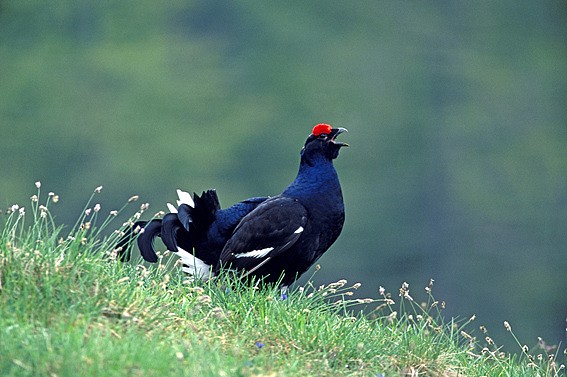Caucasian black grouse: Red Data Book of Armenia

Grouses - Tetraonidae
Status. A threatened species. Listed in the IUCN Red List of Threatened Species (ver. 3.1) as Near Threatened NT. According to IUCN criteria categorized as Vulnerable VU D1.
Distribution. The Caucasus.
Distribution in Armenia. Northern, central and southern parts of the country.
Habitats. Subalpine meadows, birch groves, rhododendron shrubs at 1800–2500 m above sea level. In winter occurs at lower elevations.
Biological traits. Non–migratory. Nestles on the ground. Lays eggs once a year from mid–April to July, depending on a site. The brooding period is 21 days. The nest is a mid–sized hole in the ground littered with herbs and fledged with feathers, beneath the shrubs or in dense herbage. Eggs are yellowish–white with reddish–brown speckles, 2–10/clutch, size 51 mm.
Population size and its trends. Available information is insufficient to judge about the population size.
Major threats. Destruction of nesting sites induced by agricultural activities. Poaching.
Conservation measures. Protected in Dilijan National Park and Shikahogh Reserve. It is essential to enforce protection of this species, strengthen anti–poaching activities and to develop the environmentally friendly ways of using the subalpine meadows.
Suggestions
 The Ministry of Environment sent a letter international partners to draw their attention to the real danger of environmental disasters as a result of Azerbaijan's large-scale aggression towards the territory of Armenia
The Ministry of Environment sent a letter international partners to draw their attention to the real danger of environmental disasters as a result of Azerbaijan's large-scale aggression towards the territory of Armenia
 Vicia pisiformis: Red Data Book of Armenia
Vicia pisiformis: Red Data Book of Armenia
 Vavilovia formosa: Red Data Book of Armenia
Vavilovia formosa: Red Data Book of Armenia
 Trigonella capitata: Red Data Book of Armenia
Trigonella capitata: Red Data Book of Armenia
 Trigonella astroides: Red Data Book of Armenia
Trigonella astroides: Red Data Book of Armenia












